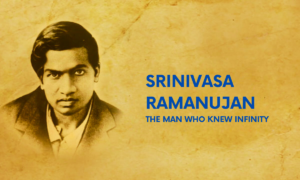8 Interesting Facts about Srinivasa Ramanujan! Who was Srinivasa Ramanujan?
Among the greatest mathematicians of all time was Srinivasa Ramanujan. His life story, with its modest and occasionally challenging beginnings, is just as fascinating on its own as his incredible body of work.
About: Born in Erode, Tamil Nadu, on December 22, 1887.Approximately 400 kilometers southwest of Madras (now Chennai), in the small village of Erode, Ramanujan was born in his grandmother’s home. Approximately 160 kilometers closer to Madras, in the town of Kumbakonam, Ramanujan’s mother took him when he was a year old. His father was employed as a clerk in a cloth merchant’s shop in Kumbakonam. He got smallpox in December 1889.
He was awarded a scholarship to the University of Madras in 1903, but he lost it the following year as a result of his obsessive focus on mathematics over all other subjects.
The first of Ramanujan’s papers appeared in the Indian Mathematical Society Journal in 1911. Read more https://daybydaynews.com/6-interesting-facts-about-guru-nanak-dev/
8 Interesting Facts about Srinivasa Ramanujan
- On December 22, 1887, Srinivasa Ramanujan was born in Erode, Tamil Nadu. His contributions to the theory of numbers are well known. Although Ramanujan would attend multiple primary schools before enrolling in the Kumbakonam Town High School in January 1898, he first attended the primary school there when he was almost five years old. Ramanujan had high expectations for himself as an all-around talented student at the Town High School, where he was expected to excel in every subject. He started working independently on arithmetic and geometric series summation in 1900.[8 Interesting Facts about Srinivasa Ramanujan]
- In 1903, Mr. Ramanujan attended Government College in Kumbhakonam. He failed tests in college because he given too much attention to maths and neglected other subjects. (Early Failures) Even though he was a mathematical prodigy, Ramanujan’s career did not begin well. In 1904, he won a scholarship to attend college, but he soon lost it due to his poor performance in non-mathematical courses. He made another unsuccessful attempt at college in Madras (now Chennai) after failing the First Arts exam. This is when he started writing in his now-famous notebooks. He lived in poverty until 1910, when he was given the opportunity to speak with the Indian Mathematical Society’s secretary, R. Ramachandra Rao. Rao initially had his doubts about Ramanujan, but in the end he saw his potential and gave him financial support.
- 1914, when he was working and received guidance from British mathematician Godfrey H. Hardy.The first of Mr. Ramanujan’s papers appeared in the Indian Mathematical Society Journal in 1911. In 1914, he went to England on a scholarship. Ramanujan wrote a letter to British Mathematician in which he stated Despite not having attended college, I have completed the required coursework. I have been using my free time to work on math since I graduated from school. I am forging a new route for myself instead of following the traditional regular course that is taught in a university. The local mathematicians describe my special investigation—which focused on divergent series in general—as ‘startling’
- Encyclopaedia Britannica states that no mathematician alive can match Mr. Ramanujan’s mastery of continued fractions. Using an original method that became known as the Ramanujan summation, he solved the Riemann series, the elliptic integrals, the hypergeometric series, and the functional equations of the zeta function.Ramanujan enclosed a lengthy list of unproven theorems with his letter, which Hardy and Littlewood examined. He responded to Ramanujan [3] on February 8th, with the following opening line:Your letter and the theorems you state piqued my curiosity greatly. You will realize, though, that I need to see evidence supporting some of your claims before I can properly assess the significance of what you have accomplished. I see roughly three classes based on your results:
Several results are well-known or readily derived from established theorems;As far as I’m aware, some results are intriguing and novel,but their apparent challenge and curiosity make them more fascinating than [8 Interesting Facts about Srinivasa Ramanujan]There are some results that, to the best of my knowledge, are novel and intriguing, but their novelty and seeming difficulty make them more intriguing than their significance; There are some results that seem novel and significant. - Acquire pi quickly. Ramanujan wrote down 17 different ways to express 1/pi as an infinite series in his notebooks. For centuries, people have been aware of series representations. For instance, pi/4 = 1 – ⅓ + ⋶ -1/7 + … is the Gregory-Leibniz series, which was discovered in the 17th century. The series converges very slowly, though; it takes over 600 terms to reach 3.14, not to mention the remaining terms. In order to reach 1/pi more quickly, Ramanujan devised a much more complex formula: 1/pi = (sqrt(8)/9801) * (1103 + 659832/24591257856 +…). After the first term, this series brings you to 3.141592, and each subsequent term adds 8 correct digits. Even though pi hadn’t been proven yet, this series was used in 1985 to calculate pi to more than 17 million digits.
- Taxicab numbers In a well-known anecdote, Hardy went to see Ramanujan by taxi. Upon arriving, he informed Ramanujan that the taxi’s number, 1729, was “quite a boring one.” “No, that is a very interesting number,” remarked Ramanujan. It is the smallest number that can be expressed in two different ways as the sum of two cubes. 1729, then, is equal to 1^3 + 12^3 = 9^3 + 10^3. The smallest numbers that can be expressed as the sum of two cubes in n different ways are known as taxicab numbers, and this number is now known as the Hardy-Ramanujan number. The next number in the sequence, 87,539,319, is the smallest number that can be written in three different ways as the sum of two cubes.[8 Interesting Facts about Srinivasa Ramanujan]
- Out of Scale 100 Hardy developed a mathematical aptitude scale ranging from 0 to 100. He estimated his age at 25. The renowned German mathematician David Hilbert was eighty years old. Ramanujan was one hundred years old. Ramanujan left behind three notebooks and a sheaf of papers (the “lost notebook”) when he passed away in 1920 at the age of thirty-two. Decades later, thousands of results from these notebooks continue to inspire mathematical work.[8 Interesting Facts about Srinivasa Ramanujan]
- Equations and Formulas:Approximately 3,900 results, mostly identities and equations, were compiled by Ramanujan. An invaluable discovery he made was the infinite series for Pi.
He provided a number of formulas for calculating Pi’s digits in unusual ways. [8 Interesting Facts about Srinivasa Ramanujan] Unknown Facts about Ramanujan Ramanujan received his Bachelor of Arts by Research degree from Cambridge on March 16, 1916 (the degree was renamed a Ph.D. from 1920). In June 1914, he had been admitted despite not meeting the requirements. Seven of Ramanujan’s papers that were published in England made up his doctorate, which was on highly composite numbers.https://www.britannica.com/biography/Srinivasa-Ramanujan
Unknown Facts about Ramanujan Ramanujan received his Bachelor of Arts by Research degree from Cambridge on March 16, 1916 (the degree was renamed a Ph.D. from 1920). In June 1914, he had been admitted despite not meeting the requirements. Seven of Ramanujan’s papers that were published in England made up his doctorate, which was on highly composite numbers.https://www.britannica.com/biography/Srinivasa-Ramanujan
In 1919, Ramanujan went back to India. At the age of 32, he passed away in Kumbhakonam a year later.
National Mathematics Day is celebrated on 22 December every year to mark the birth anniversary of legendary Indian mathematician, Srinivasa Ramanujan.
Frequently Asked Questions (FAQs)
Q1. What is special about Ramanujan?
Ans One of the greatest mathematicians in history is Srinivasa Ramanujan (1887–1920), a man whose contributions to a variety of mathematical fields, such as mathematical analysis, infinite series, continued fractions, number theory, and game theory, completely changed twentieth-century mathematics.
Q.2 What was Ramanujan’s IQ?
Ans 185



